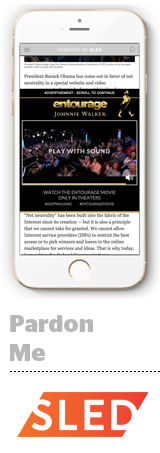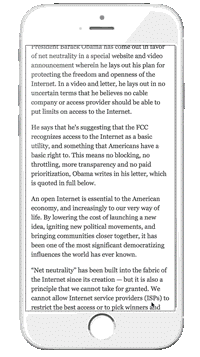 It’s high time for publishers to start transacting on time.
It’s high time for publishers to start transacting on time.
That’s the idea behind Parsec, a time-based advertising platform that was released in beta by mobile ad company Sled Mobile on Wednesday.
Rather than selling on a cost-per-impression basis, Sled will start to charge by CPS – cost per second.
For the moment, Parsec deals will be direct, although a programmatic model is on the way. Sled is partnering with Moat to provide measurement for the platform.
“An ad format has one simple job: to shift attention from content to an advertiser’s message and back,” said Marc Guldimann, CEO and founder of Sled. “And you really want to measure format delivery using an accurate proxy for attention, like time.”
Although attention metrics are starting to gain steam – analytics company ChartBeat got Media Rating Council accreditation for a desktop-centric attention-based measurement in October, with the Financial Times, Wall Street Journal and Time.com as flagship partners – it’s still going to be a hard sell to publishers and advertisers used to transacting on more traditional measurements like CPM and CTR.
“We have no problem explaining the value of time, especially in light of the awareness around viewability, because the next obvious question is: So, how long is it viewable for?” said Guldimann. “But the specifics around how to transact, the IO – that’s where the hard work is.”
But there are several agencies exploring a relationship with Sled, including Digitas and GroupM shop MEC.
Whereas a CPM’s reach is theoretical, time-based engagement demonstrates quantified impact – and that’s appealing, said Adam Shlachter, chief investment officer at Digitas. It’s the difference between potential and reality, he said, noting that Digitas is piloting Sled’s offering for several clients.
“What do we want people to do with the content and the creative assets and the messages we’re producing? We want them to pay attention, to spend time, to engage,” Schlachter said. “Time is a different way for us to approach targeting and audience reach so we can better understand the value of what we’re creating.”
Inherent within that model is a certain amount of interruption, but that doesn’t automatically have to be a bad thing. An advertiser actually needs to disrupt in order to capture attention, Guldimann said. The goal is not to annoy, confuse or surprise with no delight.
To that end, Sled offers a rich media ad format for the mobile web that Guldimann called “politely interruptive.”
 “It’s an ad that can be engaged with in the same way as the content it’s monetizing, which is the case for every medium that has ever been successfully monetized, from TV to radio to print,” he said.
“It’s an ad that can be engaged with in the same way as the content it’s monetizing, which is the case for every medium that has ever been successfully monetized, from TV to radio to print,” he said.
In other words, it’s native without attempting to blend too deeply into the content around it. A finger swipe brings the ad into view and a finger swipe clears it away. Guldimann likened the experience to flipping through a print magazine or listening to a 30-second radio spot. The ads interrupt the content, but they’re also integrated into the flow.
But it’s about more than just banners with manners, Guldimann said.
“When you buy on time vs. impressions, there’s less risk because time more closely correlates to the value advertisers are looking to achieve with their media spend,” he said. “It’s exactly the same thing that happened in the early 2000s when direct-response advertisers started to buy on cost per click rather than CPM.”
But what about desktop vs. mobile? Some might argue that time spent on mobile and time spent on desktop don’t necessarily have the same value. From Guldimann’s perspective, however, “time spent is time spent.”
“No matter whether it’s on your phone, tablet, Oculus Rift, etc., the contents and delivery method of an ad probably impact its value more than the medium used,” he said.
Sled Mobile has relationships with about two dozen publishers, including Rolling Stone, The Economist, Purch, NBC and AOL, and has run campaigns for a number of large advertisers, among them Dunkin’ Donuts, Fitbit, Adidas, Zappos, HP, KFC, Panera and Syfy’s “Sharknado 3” movie, which premiered on Wednesday.
Sled isn’t Guldimann’s first time at the startup rodeo. Before founding Sled in 2014, his previous incarnations include as CEO and founder of both desktop rich media firm Spongecell and Enliken, a company whose purpose was to help consumers take better advantage of their personal data in the form of transactions. Enliken folded at the beginning of 2014.












